Brad Guy is interim director of the Center for Construction and Environment at the University of Florida. His work focuses on “green” architecture and sustainable community development.
Monday, 8 May 2000
GAINESVILLE, Fla.
My day started off with a doctor’s appointment. Then I submitted drawings for a permit to build a shelter on the urban Depot Avenue Rail Trail and had a long talk with an auditor from the University of Florida Inspector General’s office. We discussed a number of unusual things that we’re working on at the Center for Construction and Environment, which I direct — I hope the auditor is not more confused now than she was before our meeting.
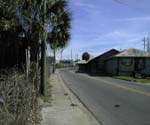
The Old Gainesville Depot, site of controversy.
The day’s big event will be a presentation and discussion at 5:00 p.m. before the Gainesville City Commission about the Old Gainesville Depot, a 1907 building that’s on the National Register of Historic Places. For about four years, I have been working to get the building rehabilitated and made into a community-serving facility. We got the city to buy the building and managed to secure a few small grants to help with architectural analysis and community and neighborhood participation. The uses we analyzed and identified as optimal include a bike rental (the building sits on the Depot Avenue Rail Trail), a community meeting space, an art exhibit, an ice cream shop, a café, and a small-scale crafts incubator, all of which would work well with a park proposed for an adjacent site.
Unfortunately, about a year ago, a woman who has been trying to create a children’s museum for many years (anywhere but in this part of town) set her sights on the building and got the city to secure a grant from the Florida Bureau of Historic Preservation to rehabilitate it. While there is nothing wrong with a children’s museum, this woman has shown the most extraordinary insensitivity in trying to use friendships with the mayor and the editorial writer for the local newspaper to circumvent the community process we have been conducting. She has stirred up bad feelings among the local neighborhood leaders.
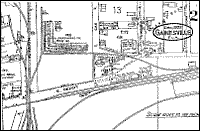
A 1922 map of the area, with the depot in the middle.
The depot is in the heart of industrial Gainesville and sits on a brownfield. The surrounding neighborhoods are predominantly African-American and lower income and have felt the disparities in infrastructure and police services for too long to appreciate a yuppie white housewife from the other side of town who wants to claim a building in the middle of the area and adapt it to a style and use that would be foreign to the realities of the area. (For example, the museum would include a Publix supermarket exhibit with plastic food so that children could play at supermarket shopping, while not three blocks away is a vibrant, real farmers market.)
We have had endless meetings with community members to identify their needs, and neighborhood leaders were gracious enough to meet with the children’s museum promoter to explain their perspectives. But she has always been incredibly vague and unresponsive, and she has no qualms about promoting her own agenda in spite of others’ efforts to work with her. The actions of the mayor and her friends are examples of the worst style of old-school backroom politics — in one person’s words, just-like-Christopher-Columbus imperialism.
We are now taking the issue to the “court” of the City Commission to try to keep the building as a mixed-use facility, and we’ve made some effort to get the neighborhood leaders out one more time for this evening’s meeting. I have tried to prepare a “professional” set of recommendations, including the option of opening up the process to allow other proposals for use of the building. It has been a long and arduous process, with several more years to go. Tune in tomorrow to find out how the meeting and discussion go tonight.
This is local, not big picture, but it has been a significant part of my activities lately and I think it’s representative of my efforts to get under-represented persons to participate (and feel like it is worthwhile participating) in the redevelopment of their areas.
Tomorrow I’ll inventory a University of Florida residence hall slated for demolition. We are trying to get the campus planning department to manage for maximum reuse and recycling of the “wastes” that will be generated.
Tuesday, 9 May 2000
GAINESVILLE, Fla.
Yesterday’s presentation and discussion before the Gainesville City Commission seemed to go OK. There were at least 12 to 14 people from the local neighborhoods, which was a good turnout. A couple of people got up and blasted the commission. One argued that there are so many critical issues of crime and neglect in the community that a museum would be a big luxury. I recommended the formation of a Depot Development Group to create an open Request for Proposals and a marketing plan to make sure people know that there are possibilities for opening small businesses in the depot building. The saga of the depot is many years from over. I just hope that the children’s museum promoters can find a way to understand the community’s concerns — after all, isn’t such a project supposed to be for the community?
I was thinking today that if you didn’t see it in front of you, you would not believe that these kinds of small-town race and class divisions really exist in this day and age. But they do. In some parts of east Gainesville, including around the Depot Avenue area, there are 40 to 70 percent poverty rates.
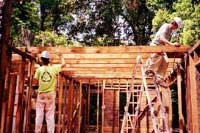
Deconstructing a house.
We did not end up inventorying the University of Florida residence hall today — we’ll do it next week. Instead I did related work, writing up reports for our “deconstruction” research.
For the past two and a half years, we have gotten funding to deconstruct old houses and analyze the cost-effectiveness of dismantling a building by hand to salvage and reuse as many of the materials as possible. Traditional demolition is done with machinery and all of the waste is thrown away. Construction and demolition (C&D) wastes comprise about 30 to 40 percent of all the wastes in the U.S. — about 136 million tons per year, the U.S. EPA estimates. Of this amount, 92 percent is from renovation and demolition and only 8 percent from new construction. C&D wastes fill up landfills and often have hazardous materials mixed in. Much of the wood thrown out could be readily reused, and some of it, like “heart” pine, is rare and potentially valuable.
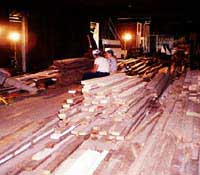
Salvaged lumber from deconstruction projects.
There are many difficulties in deconstructing buildings — dealing with lead-painted materials and asbestos, removing nails, and basic work-site safety. Still, though it takes longer and is more expensive and labor-intensive than traditional demolition, the disposal fees are lower and there is a potential return from the value of the salvaged materials. If disposal fees are high and the building has good salvage, in particular wood flooring, it may actually be more cost-effective to deconstruct. Aside from reducing the need for virgin resource extraction, deconstruction can also create jobs and make building materials available for lower-income persons and future historic preservation work.
In the end, it is more “sustainable” to reuse the entire
building intact, even if it has to be moved. I am very interested in the idea of “design for deconstruction,” which would help prevent the wholesale dismantling of buildings by making them more adaptable and would make deconstruction more user-friendly. Buildings could be constructed from non-toxic materials that are readily repairable and adaptable and that would help minimize wastes and pollution.
I think we have no choice but to start thinking in these terms, but our society is not geared to spending a little extra for something that would bring benefits in 50 years.
Wednesday, 10 May 2000
GAINESVILLE, Fla.
I’m still working away on deconstruction reports. We recently had about 500 pieces of salvaged lumber graded by the Southern Pine Inspection Bureau. A very well-trained person does a visual inspection using detailed guidelines to assess damage to the lumber from use and from the deconstruction process. The grade standards are basically a prediction of the strength of a piece of wood. Lumber that has been sitting in a house for 100 years may look undamaged, but has it retained its strength? Termite damage is of course a problem in Florida, as are holes cut in the wood for wiring or pipes, damage inflicted by bolts and nails, and the splitting of ends that can happen when two pieces of lumber are pulled apart. Being able to reuse lumber for structural purposes can add a lot of value to the material, and the more possibilities the better.

The Depot Avenue neighborhood.
Part of the Depot Avenue “eco-development” project, aside from working on the old train depot, is providing small grants for neighborhood improvement projects. We have finally received all the project proposals and we have a selection committee lined up to review them. Proposals include a neighborhood festival, trash receptacles on street corners, historical research about these older African-American neighborhoods, and entrance signs for one neighborhood.

Kids working in a community garden.
A while ago, I helped establish a community garden in the area. It is doing very well, but is mainly coordinated by a couple of people who are into gardening but do not live in the neighborhood. They submitted a proposal to expand the garden, but the guidelines for the small grants stipulate that they should go to and involve neighborhood residents. I am in a quandary as to whether we should disqualify the garden proposal or allow it to be reviewed. It would receive 0 points for neighborhood participation, which is 25 percent of the scoring, and it does not really meet the intent of the program. On the other hand, it is improving the neighborhood space. To make it worse, of course I know all the people involved. Yikes!
Thursday, 11 May 2000
GAINESVILLE, Fla.
Today I’m working on compiling information on the six houses we deconstructed in the past year. I’ve come to the interesting conclusion that it’s probably better to try to make it more expensive to throw away construction and demolition debris than to try to make the reclaimed materials more valuable (not that the deconstruction does not need to be done as efficiently and with as much care as possible).
Unfortunately, everything has a level of diminishing returns. For example, as a building is deconstructed, some materials are obviously in better shape than others — e.g., longer pieces of wood with fewer notches, less paint, and less damage from the removal process. The pieces that are shorter and more damaged are discarded because they are harder to carry and stack and have less flexibility for reuse. I can cut a longer piece to make it shorter; not so easy to make a short piece longer.
Point of all this is that the real goal is to be able to salvage materials for reuse and keep them low-cost, not to have to charge more to pay for the added labor needed to deconstruct the building versus demolish it. If the costs of demolition are really high because the costs of disposal are high, the deconstructor can charge a higher price to the original owner and be competitive without having to add his/her costs to the price of the salvaged materials. Anyway, that is my opinion. It is always going to be harder to promote the reuse of materials, for all kinds of reasons, including the perception that they are lower quality and not always super-convenient. Amazingly enough, in Europe they are going so far as to outlaw the disposal of reuseable and recyclable materials.
I went to a neighborhood meeting in the Depot area today — it was an inspiration as usual. The people are taking the initiative to make their neighborhood better and are not worried about whether they get paid or whether the work is always fun. Their meetings are held in an AME (African Methodist Episcopalian) church and always begin and end with some very fine prayers. I am not religious, but I very much enjoy this experience of a different way of being.
Leaders of this neighborhood showed up to be heard when the Depot building was being discussed earlier this week. I hope and believe that a positive side effect of that confrontation has been the beginning of some sense of empowerment. The neighborhood group is getting a sense of itself and planning a summer festival.
An interesting footnote to my description of the “battle” over the Depot building and the proposed children’s museum is that for the past few days, the local paper has featured some letters to the editor that were obviously from friends of the woman trying to push through the museum. The letters, which were pretty ugly, included personal attacks on the reporter (from the same paper) who wrote an article about a meeting between the neighborhood residents and this woman. The letters claimed that there are no better proposals than the children’s museum and that the local neighborhoods don’t really know what they want anyway, as though nothing could compare to their grand scheme. None of these letter writers were at the meeting in question.
If one wants to work in community development, one has to understand personal and political dynamics. Especially the art and science of conflict. The bottom line can be pretty ignoble.
Tomorrow is a meeting about a University of Florida residence hall slated for demolition. We’re trying to convince the powers that be to reuse the brick from this building in the construction of a new building. I am not holding my breath, but we have to do the best we can.
Friday, 12 May 2000
GAINESVILLE, Fla.
One might think I spend my days dreaming about dismantling buildings, which doesn’t seem very environmentally conscious. In fact, I do not wish to see buildings dismantled. What I do wish to see is the built environment improve in all regards, becoming more healthy, more uplifting, more conservative of energy and other resources (35 percent of carbon-dioxide emissions in the U.S. each year come from constructing and operating buildings), and simply more humane. The urban environment of cities is the expression of cultures and provides aesthetic and functional value to the lives of inhabitants. Cultures should appreciate both the untouched resources of nature and resources that have been made into human artifacts. This is important not just from a consumption and population perspective, but because cultures that honor these things have more soul.
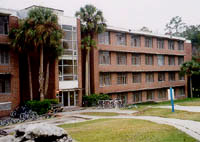
Hume Hall, soon to be a pile of rubble.
In spite of these musings, the real world i
s still at work. First thing this morning, we had a long meeting with the University of Florida Campus Planning people and some of their consultants about Hume Hall, the 133,000-square-foot residence building that is going to be demolished this fall. They are going to do everything they can to see that bricks are saved and reused in a new building that they will start constructing about six months after Hume Hall’s dismantling. One of the project planners, Howie Ferguson, has been our champion, and without him we would not be in the door. He has gotten our message 100 percent.
After returning from that meeting, I had a call about a high school auditorium that is going to be demolished because the clay soils under it are settling and it is literally falling apart. This building is all brick and we are going to try to see how the brick can be saved and possibly reused on the University of Florida campus. After all, what better market for brick than a college campus with a master plan that requires all new buildings to be entirely clad in brick! Maybe I should start a business.
On Monday I am going to Tallahassee for the Florida Sustainable Communities Network Roundtable conference. Among other people, the infamous James Howard Kunstler will be there, speaking about the destruction of the U.S. via suburbanization. I am looking forward to seeing Margaret Thomas from the Midwest Research Institute. She has done a lot of research and produced guides on the topic of “sustainable” economic development. This is really where it is at — trying to develop alternative energy, alternative materials, alternative transportation, alternatives that can give people a reasonable quality of life without incredibly wasteful and indiscriminately harmful activities.
Next week we hope to reconnect with the St. Petersburg Housing Authority about its plans to tear down a housing project (formerly military base housing) and replace it with housing that is more habitable. By having the housing residents do some deconstruction and teaching them the techniques and business skills they would need to operate a used building materials store, the housing authority might be able to create some long-term “sustainable” jobs. Just giving housing residents the initial construction-site training about safety and tools could be a great springboard to help them develop other construction skills.
These days I am enjoying reading Believing Cassandra by Alan AtKisson — his style of writing is very uplifting. I know the references he uses and have read his reports for Sustainable Seattle in the past. [Editor’s note: Read Donella Meadows’s review of Believing Cassandra.]
OK, enough — thank you for reading my diary. Time for me to get moving on other projects — so much to do and learn. Have fun yourself!


